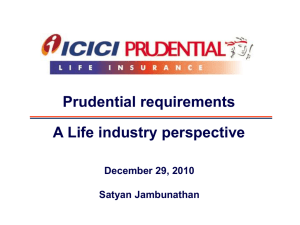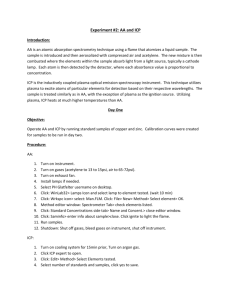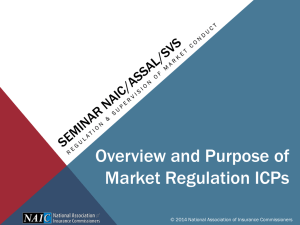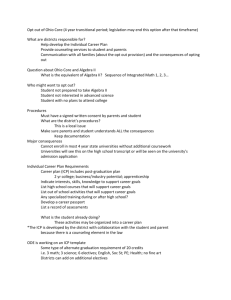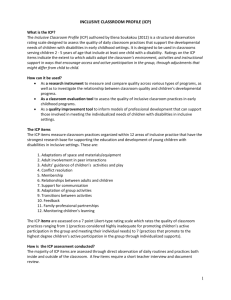Presentation 4
advertisement
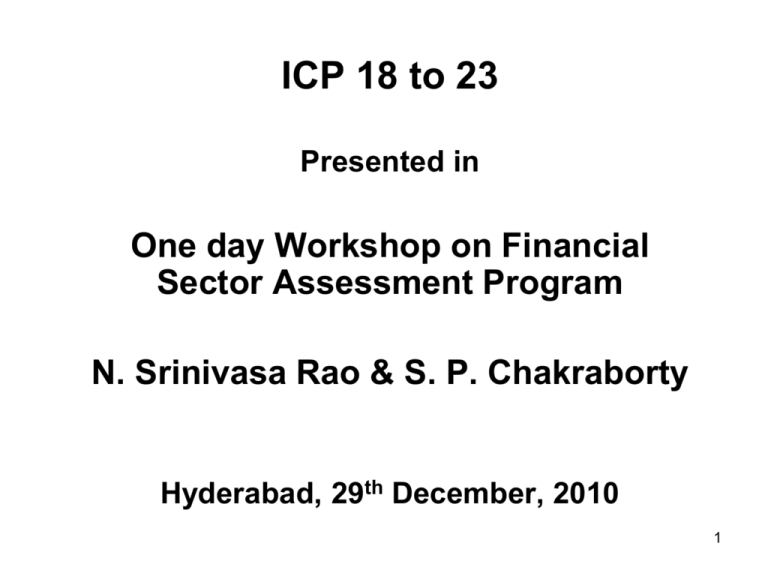
ICP 18 to 23 Presented in One day Workshop on Financial Sector Assessment Program N. Srinivasa Rao & S. P. Chakraborty Hyderabad, 29th December, 2010 1 ICP – 18 to 23 Agenda • Principles • Essential Criteria for assessment • Observance of principles/current practice 2 ICP – 18 Risk Assessment & Management Principle: The ‘Supervisory Authority’ requires insurers to recognize the range of risks that they face and to assess and manage them effectively 3 ICP – 18 Risk Assessment & Management Essential Criteria for assessment • Comprehensive risk management policies • Appropriateness of such policies • Monitoring and control system • Review and analysis of impact of external environment • Larger insurers establish a risk management function and a risk management committee. 4 ICP – 18 Risk Assessment & Management Observance of principles • Appointed Actuary’s Annual Report Provides a framework for prudent risk management system Experience Analysis Projection of future financial condition Asset Liability management 5 ICP – 18 Risk Assessment & Management Observance of principles • Economic Capital Mandatory for all life insurers to submit the report Provide guidance as to various risk assessment and quantification 6 ICP – 18 Risk Assessment & Management Observance of principles • Financial Condition Report for Non-life Companies Analysis of business Demonstration of adequacy of premiums and reserves Risk management – Not comprehensive 7 ICP – 18 Risk Assessment & Management Observance of principles • Quarterly solvency reporting; If situation warrants, on monthly basis • Financial Condition Report for life companies • Submission of re-insurance programme • Actuarial Review Committee • Peer Review system • Risk Management Committee as per corporate governance guidance 8 ICP – 19 Insurance Activity • Principle Since insurance is a risk taking activity, the supervisory authority requires insurers to evaluate and manage risks that they underwrite, in particular through reinsurance and to have the tools to establish an adequate level of premiums. 9 ICP – 19 -Insurance Activity Essential Criteria for assessment • Strategic underwriting and pricing policies • Evaluation of underwriting risks and adequacy of premium rates; Expense management. • Ability of the Authority to review the method and basis of premium rate computation 10 ICP – 19 -Insurance Activity Essential Criteria for assessment • Check on adequacy of reinsurance arrangement and ensure that the claims held by insurers on their reinsurers are recoverable. This includes that: The reinsurance coverage is appropriate to the level of capital of the insurer and the profile of the underwritten risks Reinsurers protection • Appropriateness of risk transfer instruments 11 ICP – 19 -Insurance Activity Observance of principles • Appointed Actuary System Part and parcel of the entire system covering insurance activity and risk management Key responsibilities: Actuarial advice to management on important issues Ensure solvency at all times Certification Whistle blowing 12 ICP – 19 -Insurance Activity Observance of principles ‘File & Use’ procedure Product design – suitability for target market Terms & conditions including exclusions, surrender, foreclosure etc. Underwriting policy Pricing & Reserving– Methodology and Basis Profitability Scenario & Sensitivity testing Risk of mis-selling – Benefit Illustration The insurers review the premium rates on periodic basis depending on their actual experience thru’ ‘F&U’ procedure 13 ICP – 19 -Insurance Activity Observance of principles • Non-Life ‘File & Use’ procedure Required to review rates on regular basis Any change in the UW policy to be approved by the BOD. Authority reviews the methodology and basis used by the insurers to set premium rates. • Appointed Actuary’s certificate on rates are fair and terms & conditions offered are workable and sound. 14 ICP – 19 -Insurance Activity Observance of principles • The Authority reviews the reinsurance programme of general insurers with particular reference to the re-insurance treaty slips and XOL cover note and analyze the data submitted thereon • Appropriate provision for IBNR on Reinsurance accepted portfolio on actuarial basis 15 ICP – 20 -Liabilities • Principle The supervisory Authority requires insurers to comply with standards for establishing adequate technical provisions and other liabilities, making allowance for re-insurance recoverable. The supervisory Authority has both the authority and the ability to assess the adequacy of the technical provisions and to require that these provisions be increased, if necessary. 16 ICP – 20 -Liabilities Essential Criteria for assessment • Legal provisions are in place to establish adequate technical provisions and other liabilities based on sound accounting and actuarial principles. • Prescribes/agrees to standards for establishing such provisions. • Specific factors to consider when developing such standards 17 ICP – 20 -Liabilities Essential Criteria for assessment • Review of sufficiency of technical provisions (ICP 12 & 13 – Offsite and Onsite inspection) • Provisions to increase technical provisions, if not appropriate • The Authority ensures that the standards stipulate general limits for the valuation of the amounts recoverable from the reinsurance arrangements, sound accounting principles for booking of such amounts and the credit for the technical provisions for amounts recoverable under re-insurance arrangements. • Requirements to carry out stress testing in case technical provisions are increased. 18 ICP – 20 -Liability Observance of principles • Section 13 & 15 of the Insurance Act, 1938, ARA and ALSM Regulations Prescribes methodology and principles to be used for setting assumptions Prudent - Best Estimate + MAD basis (Life) Provisions for ‘Global Reserves’ Detailed guidelines on computation of IBNR and IBNER provisions – Non Life Provisions for deficiency in premiums – Non-life • Insurers may be required to increase the provisions, if requires. 19 ICP – 20 -Liability Observance of principles • Reinsurance Liability side – restrictions in computation of RSM Asset side – No credit for claims recoverable from reinsurers due for over 90 days for demonstration of solvency. Amounts recoverable from reinsurers are disclosed in the financial statements. • The AAAR requires stress testing on prescribed basis • stress testing framework is to be developed in non-life companies 20 ICP – 23 –Capital Adequacy and Solvency Principles: • Insurers to comply with the prescribed solvency regime. • The regime includes capital adequacy requirements and requires suitable forms of capital that enable the insurer to absorb significant unforeseen losses 21 ICP – 23 –Capital Adequacy and Solvency Principles: • The solvency regime addresses valuation of assets and liabilities, suitable form of capital and capital adequacy requirements • Effectiveness and security of the counterparty with regard to risk transfer • Solvency control levels are established • Inflation of capital through double or multiple gearing etc. • Requirements placed upon an insurer operating through a branch 22 ICP – 23 –Capital Adequacy and Solvency Observance of principles • The solvency regime – Two factor formula based The minimum solvency capital requirement is 150% of the required solvency margin (current practice) The required capital is capable enough to absorb the significant unforeseen losses IRDA closely monitors the solvency control level on regular basis so that any corrective action can be taken well in advance Sensitive to line of business and specific features such as Par, Non-par, guarantee or without guarantee Not directly sensitive to specific risk profile of the insurer 23 ICP – 23 –Capital Adequacy and Solvency Observance of principles • Principles of asset valuation are prescribed in the regulations • Insurers hold mismatching reserves, if needs • Risk transfer is only in the form of re-insurance arrangement • Minimum credit rating for re-insurers. • No comprehensive regulations for supervising reinsurance business. • Foreign insurers are not allowed to operate in India thru’ branch • Form of Capital – Thru’ ordinary shares with single face value 24 ICP – 21 - Investments • Principle The supervisory authority requires insurers to comply with standards on investment activities. These standards include requirements on investment policy, asset mix, valuation, diversification, assetliability matching, and risk management 25 ICP – 21 – Investments Essential Criteria • Requirements regarding the management of investments are in place, either in the law or in supervisory rules. These requirements address, but may not be limited to, the following: • the mixture and diversification by type • limits or restrictions on the amount that may be held in particular types of financial instruments, property, and receivables • the safekeeping of assets • the appropriate matching of assets and liabilities • the level of liquidity 26 ICP – 21 – Investments Essential Criteria • Investments are valued according to a method prescribed by or acceptable to the supervisory authority. • The supervisory authority requires insurers to have in place an overall strategic investment policy, approved and reviewed annually by the board of directors • The risk management systems must cover the risks associated with investment activities that might affect the coverage of technical provisions and/or solvency margins (capital). 27 ICP – 21 – Investments Essential Criteria • The supervisory authority checks that insurers have in place adequate internal controls to ensure that assets are managed in accordance with the overall investment policy, as well as in compliance with legal, accounting, and regulatory requirements. • The supervisory authority requires that oversight of, and clears management accountability for, an insurer’s investment policies and procedures remain ultimately with the board of directors, regardless of the extent to which associated activities and functions are delegated or outsourced • Requirement of appropriate staff • Requirement of rigorous audit procedure in place 28 ICP – 21 – Investments Essential Criteria • The supervisory authority requires that insurers have in place effective procedures for monitoring and managing their asset/liability position to ensure that their investment activities and asset positions are appropriate to their liability and risk profiles • The supervisory authority requires that insurers have in place contingency plans to mitigate the effects of deteriorating conditions 29 ICP – 21 – Investments Observance of principles • Investment Regulations Management of investments within the insurer. Lays down norms in terms of types of investment, exposure limits to group companies and limits on investment in any single industry sector Emphasize security of investments thru’ mandatory investments in ‘Govt’ and other approved securities. Insurer to form an investment committee Investment policy is required to be approved by the BOD and required to be reviewed on periodic basis The IRDA issued guidance on the requirements of the entire investment function which should be covered in the investment policy 30 ICP – 21 – Investments Observance of principles • Valuation of investments are prescribed in the regulation • Insurance funds are required to be invested in India only • Various investment returns on periodic basis (Quarterly and half yearly) • Onsite inspection of investment activities • Requirements to have a sound methodology for asset liability management. 31 ICP – 22 Derivatives and similar commitments • Principle The supervisory authority requires insurers to comply with standards on the use of derivatives and similar commitments. These standards address restrictions in their use and disclosure requirements, as well as internal controls and monitoring of the related positions. 32 ICP – 22 Derivatives and similar commitments Essential Criteria • Requirements regarding the use of derivatives are in place, either in the law or in supervisory rules. The requirements consider the risks in the use of derivatives and similar commitments. • Disclosure requirements for Derivatives and similar commitments. • Requirement of sufficient expertise to understand the important issues related to the use of derivatives, and that all individuals conducting and monitoring derivatives activities are suitably qualified and competent. 33 ICP – 22 Derivatives and similar commitments Essential Criteria • Requirement of an appropriate policy for derivatives which should be reviewed annually by BOD • Comprehensive ‘Derivatives’ risk management system • Proper internal control for management of derivatives activities • Expertise to handle such activities 34 ICP – 22 Derivatives and similar commitments Observance of principles • Very limited use of derivatives in India • The regulations allow hedging of interest rate risk. Fixed Income derivatives (Forward rate agreements, Interest Rate swaps and exchange traded interest rate futures) are allowed • Insures are required to disclose risk management policy in detail • The investment policy including the internal control system must be approved by the BOD of the insurer 35 Thank You 36
